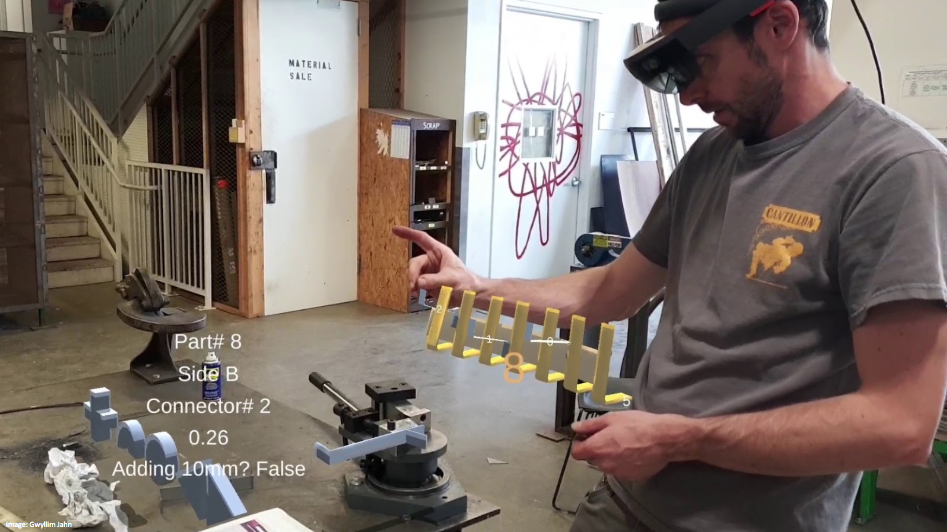Tyler School of Art and Architecture students participated in the Holographic Handcraft Workshop and built a sculptural prototype using augmented reality technology supplied by industry partner Fologram

Sculpture created in Tyler's Holographic Handcraft Workshop in Tyler's lobby during the summer 2019. This sculpture will be on display at the Cherry Street Pier during the DesignPhiladelphia 2019 festival in early October, 2019.
In the Tyler School of Art and Architecture’s first-ever Holographic Handcraft Workshop, Tyler students and faculty in five academic programs used augmented reality technology to investigate design solutions for industry partner Fologram, an Australian software developer. The four-day workshop produced a 10-foot-high, sculptural prototype that will be on display at the Cherry Street Pier during the DesignPhiladelphia 2019 festival in early October and helped inform the production process on Fologram’s award-winning pavilion at the 2019 Tallinn Architecture Biennale (TAB) in Estonia.
The team of Tyler fabricators assembled the graceful sculpture—made out of 44 two-meter pieces of wood—while wearing Fologram’s HoloLens augmented reality goggles, which allowed them to visualize a three-dimensional virtual “blueprint” of what they would be building. Students and faculty from Tyler’s Architecture, Ceramics, Glass, Metals/Jewelry/CAD-CAM and Sculpture programs contributed to the project.
The Holographic Handcraft Workshop was the product of an invitation from Andrew John Wit, assistant professor of architecture at Tyler, to Fologram—an Australian firm known for mixed reality applications—to partner on a curriculum-based project.
“We collaborated with [Fologram co-founder] Gwyllim Jahn and [Airbnb technologist] James Pazzi on the design and constraints of the prototype,” Wit said. “Fologram developed the software and computational model while Tyler explored fabrication techniques and feasibility. Through the proprietary HoloLens augmented reality headset, the build team was able to directly translate the prototype design from digital space to the physical, without the use of a single drawing.”
The creation of Tyler’s prototype sculpture helped inform the fabrication processes used for Fologram’s “Steampunk” pavilion at TAB, which consists of 250 12-meter wooden pieces. “Steampunk” won TAB’s 2019 Huts and Habitats competition and will be on display at the Museum of Estonian Architecture through November 17, 2019. As part of DesignPhiladelphia 2019, Tyler's sculpture will be on exhibit October 2–13, 2019 at the Cherry Street Pier (121 N. Christopher Columbus Blvd.).
Using augmented reality is “kind of like ‘IKEA-izing’ the assembly,” said Christopher McAdams, an assistant professor of instruction in Tyler’s Architecture Program. “You’re working in real-time through the goggles, which shares layers of information in front of you. You make what you see.”

A Tyler student assembles the sculpture, using Fologram's HoloLens goggles, as seen from the perspective of another user of the augmented reality goggles.
“Augmented reality is revolutionizing the building industry,” McAdams continued. “This project is something that couldn’t have been described through conventional architectural drawings. Exposing students to these new tools and a project with this level of sophistication will be a tremendous advantage for their future careers.”
“Not only that,” Wit added, “but interdisciplinarity is important to architecture. We can accomplish much more when we work outside our disciplines and play to each other’s professional and creative strengths.”
Students in Tyler’s studio art disciplines, who have experience with woodshop tools, helped lead the construction of the sculpture through the creation of jigs and the use of power and hand tools. Conversely, the architecture faculty and students were well-versed in the lexicon of planning as well as the processing of digital, 3-D models.
At any given moment during the workshop, a different student would step up and lead the group to help advance the project. In this fashion, Tyler students replicated actual professional scenarios, exchanging ideas, contributing strengths and collectively troubleshooting in order to accomplish the dynamic end result.
“My capstone studio with Professor Wit was centered on architecture that utilizes emerging technology, so getting to experience a hands-on build using the HoloLens goggles was both incredible and invaluable.” – Michael Willhoit, graduated senior in architecture
Not only did the Holographic Handcraft Workshop provide students with a taste for what goes into the planning and production of an ambitious work, it introduced innovative technologies that extended their abilities and talents as thinkers and makers.
“We have a unique opportunity and advantage at Tyler,” Wit said. “Every discipline here is exploring these progressive technologies, but we’re also invested in traditional practices. It’s important to offer students both ends of the spectrum. These technologies are not replacing handcraft, they are pushing the limits of what humans can create.”
Photo of Students using HoloLens courtesy of Gwyllim Jahn